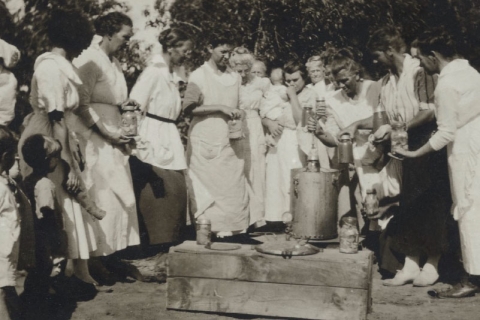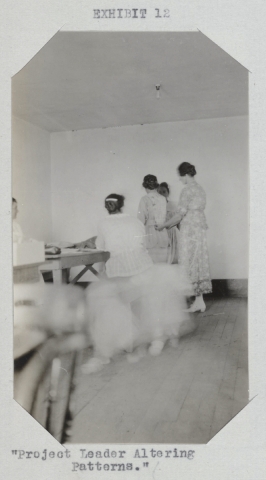Last month, I introduced the history of the development of the Merced County Farm Bureau as documented in the early reports of the county agent. These reports, as well as historical photographs, are now freely available in digital form through Calisphere. Working alongside the county agent was a home demonstration agent who was responsible for organizing activities to solve problems and improve practices which affected “physically, socially, or economically the homes of the community.” In December 1920, after her first year in the county, agent Mary Van Camp reported that fifteen centers had been organized in the county with a membership of 401 women engaged in a program of work for each farm home department center.
What is striking to me about her report is the consistent emphasis on the development of local leaders. It was up to each center to decide what problems they wanted to raise attention to and promote training to address. Across the county, the “problems” identified were clothing, food, and improved health and sanitation. While the agent’s role was to advise and provide demonstrations, she describes her role as putting “as much confidence in the ability of the local leader as she could[,] checking methods when undesirable and praising where methods used were good.” That speaks volumes about the spirit behind Cooperative Extension and its approach. “It is interesting to note,” Van Camp writes, “that each different leader is planning the work as best fits her environment.” Her report records insights into the different needs of each community, how sharing models and practices can inspire local initiatives, and how to best foster and support locally-led problem solving.
The Start of School Hot Lunches
After a child feeding demonstration was conducted in a one room rural school in Livingston, local leadership organized to improve the school lunch situation. Teachers, a local nurse and physician, as well as the county superintendent of schools, worked together to introduce hot lunches and improve sanitation at the schools. With a number of photographs, Van Camp makes the point that children no longer needed to sit on the ground outside to eat their lunches. Instead, in cold weather children were served a hot dish, and “pupils mob the home demonstration agent on the road to tell her they have gained a pound.”

Food Preservation and Clothing Techniques
We may not have expected that 2020 would bring a renewed interest in canning (news reports have noted shortages in canning supplies) as well as other at-home activities such as sewing and knitting. A hundred years ago, home demonstration agents played a key role in showing homemakers how to safely preserve food and how to make their own clothing efficiently. That knowledge would become even more valuable as communities later weathered the Great Depression and shortages during the Second World War.
Van Camp reports on demonstrations on “cold pack sterilization, pressure cooker, water bath and steam bath” methods for canning vegetables and meats. A Mrs. L’Hommadieu of Stevinson even hosted a demonstration at her home on the use of a canning retort, where a 35 lb. pig was preserved alongside eight quarts of beans.

In another photograph in the report, she depicts a project leader demonstrating how to alter dress forms for clothing. A blur of movement in the foreground of the photo are the toddlers in the room watching as well.

For those interested in learning more about the history of canning techniques, the National Agricultural Library has a wonderful digital exhibit on The Evolution of Home Canning Practices.
This spring, the UC Merced Library is teaming up with Merced 4-H to inspire local youth to create their own digital exhibits and tell their own local stories. We are accepting registration for a county-wide project to begin in January. Students 8th grade and up will learn to use digital archives, Arc GIS Story Map software, and other digital tools. We are excited to see what students come up with and what histories they uncover!
This article was published in the December 2020 issue of the Merced County Farm News.

